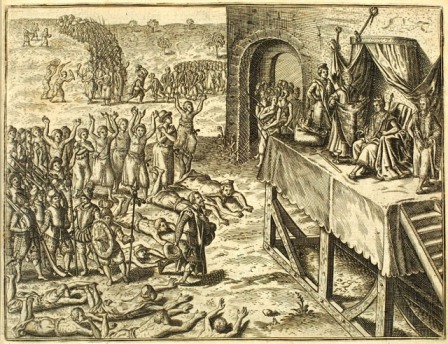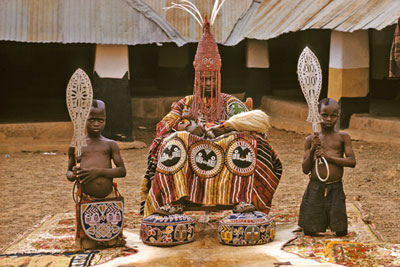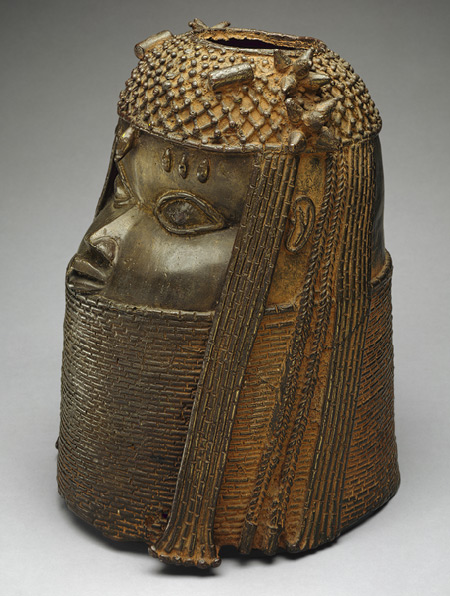Oba
In “The Fortuitous Meeting”, Oludara is called from his village to appear before the Oba of Ketu.
During Oludara’s lifetime, the supreme ruler of each Yoruba kingdom is known as an oba. In most cases, they trace their ancestry back to the Orisha Oduduwa, creator of the earth, and thus they are considered sacred. Subjects must prostrate themselves before an oba, after which they may sit or kneel on the ground in his presence.
Subjects prostate themselves before an African oba as the Portuguese make their first contact – Late fifteenth century
(Image: Wikipedia, public domain)
Only obas may wear the sacred Yoruba regalia: a conical bead crown, beaded slippers, and a beaded fly whisk. The crowns are made from red coral beads, first introduced by the Portuguese. Obas have several different crowns for different occasions, and each crown has its own history. These crowns contain lines of beads which cover the oba’s face, in order to protect subjects from his divine gaze.

Oba Ademuwgun Adesida II in full regalia, 1959.
(Image: Smithsonian Institution. Photo by by Eliot Elisofon)
The oba is responsible for resolving problems external to the kingdom, and is the maximum authority on questions of justice. He is aided by a council of elders, who will also choose his successor upon his death. The village bale (chiefs), typically the eldest of the clan, handle local matters.
Due to the oba’s sacred nature, it is unthinkable to commit an act of violence against his person. In some circumstances, however, the oba may have to perform violence against himself. Once such circumstance is when the people rise up in protest against the oba’s rule, in which case the chiefs may demand the oba’s suicide. Tradition also dictates that the oba can also never come face to face with the Oni Oja (the market chief), under penalty of death. Thus, he can never leave the palace on market day.
The crowning of a new oba is a long, ceremonial process, requiring the future oba to make a pilgrimage through various shrines and holy places and participate in many rituals before returning to his city for coronation. It often takes months to complete all the steps. To give one example, the Ida Oranyan (Oranyan’s Sword, the Sword of Justice) must be brought from Ile-Ifé and placed in the the Oba of Oyo’s hand before he can come into power.
Once crowned, the king almost never ventures out during the daytime, except during a few very important festivals. He may, however, leave his palace in cognito at night.
Brass oba head – Sixteenth century
(Image: www.metmuseum.org)
The obas still exist throughout the Yoruba kingdoms today, although traditions have been modernized, particularly during the last hundred years. For example, the custom of suicide has disappeared over time, but the Alaketu Adegbede was forced to take his own life as recently as 1858! When he was called from his palace and saw the Oni Oja (perhaps by arrangement from his enemies), he and two of his wives had to drink poison.
Those who visit Africa today may have a chance to visit one of the Yoruban obas and learn more about their long traditions. I hope to make my own visit soon!






